
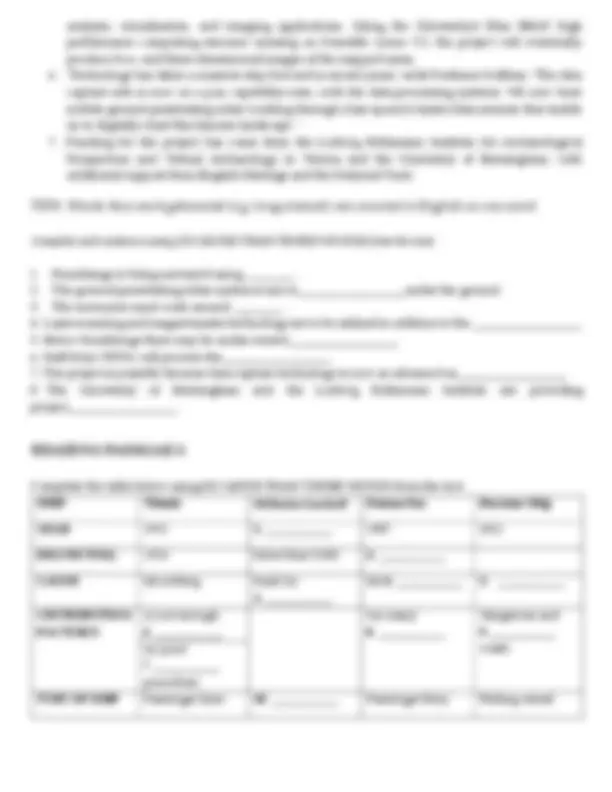
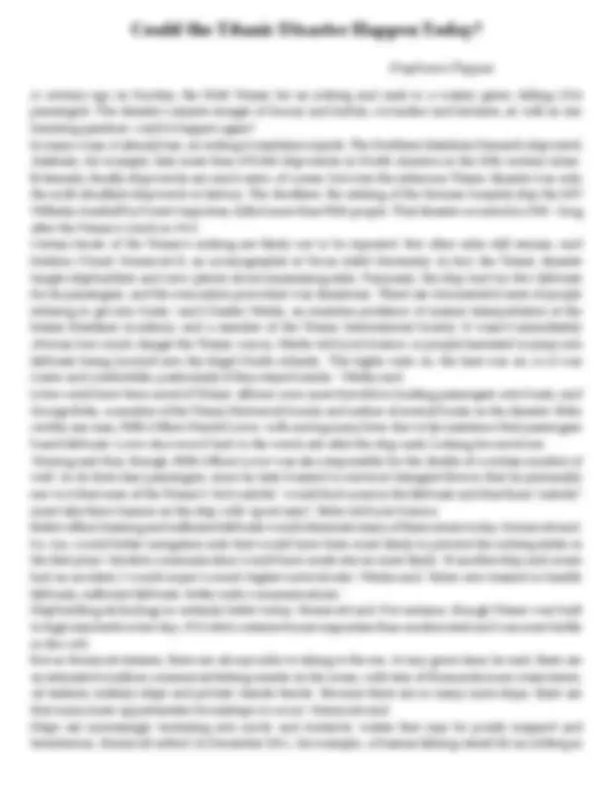
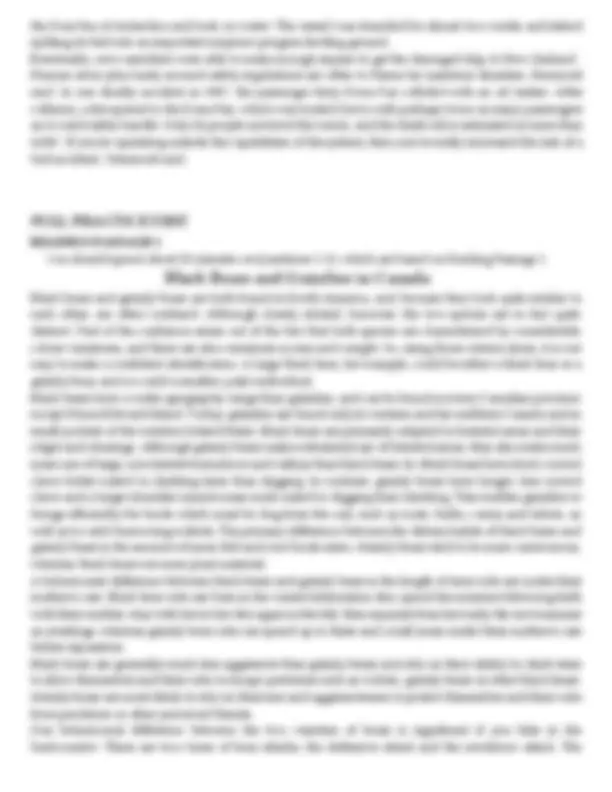
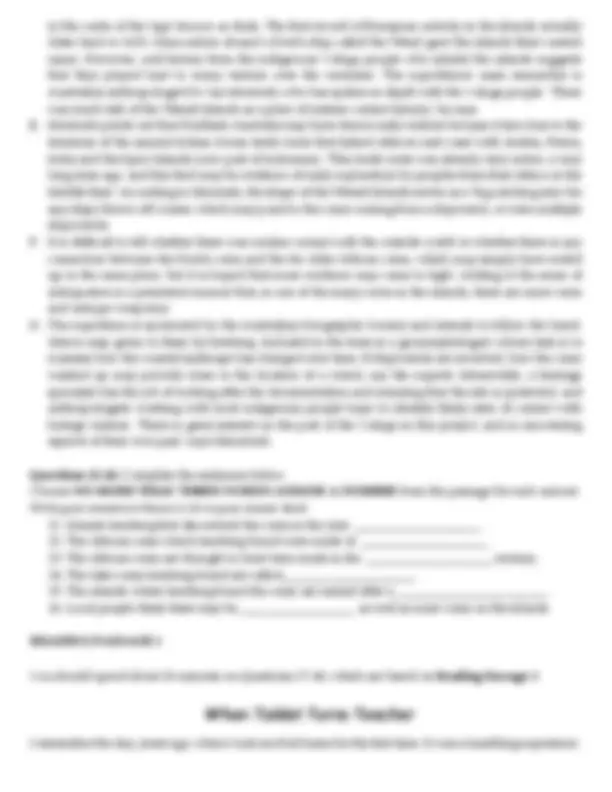
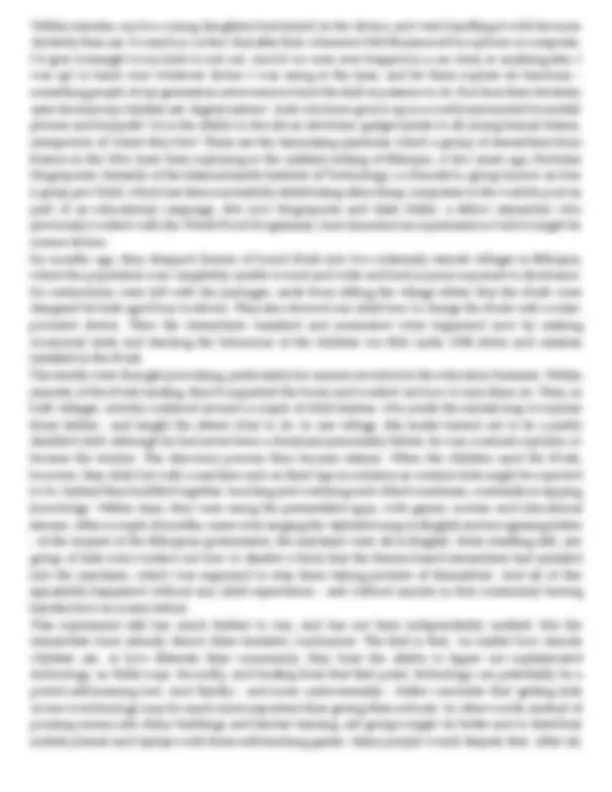
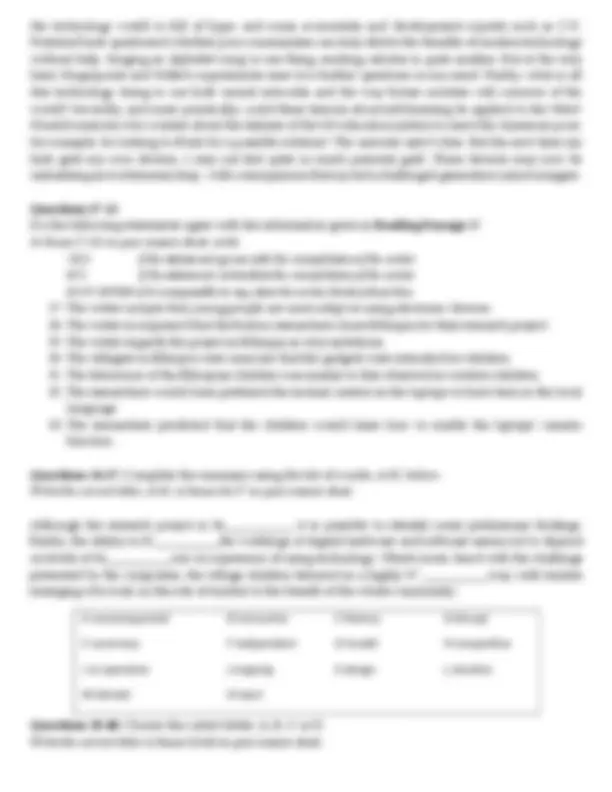


Study with the several resources on Docsity

Earn points by helping other students or get them with a premium plan


Prepare for your exams
Study with the several resources on Docsity

Earn points to download
Earn points by helping other students or get them with a premium plan
Community
Ask the community for help and clear up your study doubts
Discover the best universities in your country according to Docsity users
Free resources
Download our free guides on studying techniques, anxiety management strategies, and thesis advice from Docsity tutors
Bài tập đọc theo chuyen ngành quốc tế học và các dự liệu liên quan đến tiến trình ghiên cứu châu Á - Thái Bình Dương
Typology: Exercises
1 / 11

This page cannot be seen from the preview
Don't miss anything!







With heatwaves gripping much of the planet every summer, electricity companies worry that they may
not be able to generate enough energy to meet demand during the warmest months because air-
conditioning systems use a tremendous amount of energy. However, one group of forward- thinking
designers believe that they may be able to find the answer by studying the way other creatures function.
Through a process known as biomimicry, they aim to use designs inspired by the natural world to
address human problems.
The idea is that over billions of years, nature itself has solved many problems which are similar to those
that humanity faces today. In natural systems, nothing is wasted, since everything can be used by
something else. Human manufacturers, on the other hand, use large inputs of nonrenewable energy,
produce toxic chemicals as by-products and then ship finished goods across the globe. Nature makes
what it needs, where it needs it, using water-based chemistry. The following designs are examples of
how this approach might be applied to the issue of air-conditioning:
1. Ventilation inspired by termites
Perhaps the most famous example of biomimicry when it comes to heating and cooling is ventilation
inspired by termites. A few years ago, scientists observed that big termite mounds in Africa stay
remarkably cool inside, even in blistering heat. The insects accomplish that feat by creating air pockets in
strategic places in the mounds they inhabit. This clever design creates a natural ventilation system,
driving air through the mound through the process of convection. Architect Mick Pearce and engineering
firm Arup borrowed that idea to build the Eastgate Centre, a large office and shopping centre in
Zimbabwe that is cooled with the outside air. The system uses only 10% as much energy as conventional
air-conditioning.
2. Countercurrent heat exchange inspired by birds
Penguins that live in cold climates have an innovative adaptation that helps them survive in frigid water.
The veins and arteries in their feet have a countercurrent configuration, which ends up warming the
blood that is closer to the animal's core and cooling the blood at its extremities. By keeping cooler blood
closer to the snow and icy water, such birds lose less body heat overall. Heat exchangers in industrial-
scale heating and cooling systems use a similar type of principle to maximize efficiency.
3. Moisture absorption inspired by ticks
A system called a liquid desiccant dehumidifier is designed to pull humidity from the air inside a
building (traditional air-conditioning also reduces humidity). It uses a liquid salt solution - something
similar to the liquid that a parasitic insect called the brown dog tick secretes to absorb water from the air.
In another take on better fan design, a company called WhalePower is developing fan blades that produce
greater lift, and therefore move more air, thanks to an idea inspired by the bumpy design of a humpback
whale's flipper. WhalePower says its fans move 25% more air than conventional fans while using 20%
less energy. The company is also working on more powerful wind turbine blades.
Questions 1- 8
Answer the questions below
Choose NO MORE THAN THREE WORDS from the passage for each answer
prehistoric monument in Wiltshire. The Stonehenge Hidden Landscapes Project is using advanced
geophysical imaging technology to survey the 14 sq km site over approximately nine weeks spread
over a three-year period.
archaeological survey, with every inch of the targeted terrain scanned to a depth of three metres
using high-frequency ground-penetrating radar (GPR) systems from Swedish firm MALA
Geoscience. The survey is scheduled around the needs of farmers and small-holders whose lands
about the Stonehenge site.
together a 12 - member multi-disciplinary team that includes archaeologists, geophysicists,
historians, and computing specialists. As well as the GPR they will use laser scanning and
magnetometer technology to enhance their understanding of the site.
much of it remains terra incognita,' says project leader Professor Vince Gaffney. 'We don't even
know if we are aware of all the monuments that may exist under the Stonehenge site itself.
Even people connected with Stonehenge are surprised that it has not been surveyed in this level
of detail before. We can discover the "hidden landscape” in a way that you can't really do through
invasive work. '
Technology Centre (VISTA), which supports academic research and development for spatial
A century ago on Sunday, the RMS Titanic hit an iceberg and sank to a watery grave, killing 1514
passengers. The disaster conjures images of luxury and hubris, cowardice and heroism, as well as one
haunting question: could it happen again?
In many ways, it already has, according to maritime experts. The Northern Maritime Research shipwreck
database, for example, lists more than 470,000 shipwrecks in North America in the 20th century alone.
Extremely deadly shipwrecks are much rarer, of course, but even the infamous Titanic disaster was only
the sixth-deadliest shipwreck in history. The deadliest, the sinking of the German hospital ship the MV
Wilhelm Gustloff by Soviet torpedoes, killed more than 9000 people. That disaster occurred in 1945 - long
after the Titanic's wreck in 1912.
Certain facets of the Titanic's sinking are likely not to be repeated. But other risks still remain, said
Mahlon 'Chuck' Kennicutt II, an oceanographer at Texas A&M University. In fact, the Titanic disaster
taught shipbuilders and crew plenty about minimizing risks. Famously, the ship had too few lifeboats
for its passengers, and the evacuation procedure was disastrous. 'There are documented cases of people
refusing to get into boats,' said Charles Weeks, an emeritus professor of marine transportation at the
Maine Maritime Academy, and a member of the Titanic International Society. It wasn't immediately
obvious how much danger the Titanic was in, Weeks told Live Science, so people hesitated to jump into
lifeboats being lowered into the frigid North Atlantic. 'The lights were on, the heat was on, so it was
warm and comfortable, particularly if they stayed inside, ' Weeks said.
Lives could have been saved if Titanic officers were more forceful in loading passengers onto boats, said
George Behe, a member of the Titanic Historical Society and author of several books on the disaster. Behe
credits one man, Fifth Officer Harold Lowe, with saving many lives due to his insistence that passengers
board lifeboats. Lowe also rowed back to the wreck site after the ship sank, looking for survivors.
'Having said that, though, Fifth Officer Lowe was also responsible for the deaths of a certain number of
well - to-do first-class passengers, since he later boasted to survivor Margaret Brown that he personally
saw to it that none of the Titanic's "rich nabobs” would find a seat in the lifeboats and that those "nabobs"
must take their chances on the ship with "good men",' Behe told Live Science.
Better officer training and sufficient lifeboats would eliminate many of these issues today, Kennicutt said.
So, too, would better navigation aids that would have been more likely to prevent the iceberg strike in
the first place. Modern communication would have made rescue more likely. 'If another ship mid-ocean
had an accident, I would expect a much higher survival rate,' Weeks said. 'More crew trained to handle
lifeboats, sufficient lifeboats, better radio communications.'
Shipbuilding technology is certainly better today, Kennicutt said. For instance, though Titanic was built
to high standards in her day, 1912 steel contained more impurities than modern steel and was more brittle
in the cold.
But as Kennicutt stresses, there are always risks to taking to the sea. At any given time, he said, there are
an estimated 4 million commercial fishing vessels on the ocean, with tens of thousands more cruise liners,
oil tankers, military ships and private vessels beside. 'Because there are so many more ships, there are
that many more opportunities for mishaps to occur,' Kennicutt said.
Ships are increasingly venturing into Arctic and Antarctic waters that may be poorly mapped and
treacherous, Kennicutt added. In December 2011, for example, a Russian fishing vessel hit an iceberg in
the Ross Sea of Antarctica and took on water. The vessel was stranded for almost two weeks and risked
spilling its fuel into an important emperor penguin feeding ground.
Eventually, crew members were able to make enough repairs to get the damaged ship to New Zealand.
Human error plus laxity around safety regulations are often to blame for maritime disasters, Kennicutt
said. In one deadly accident in 1987, the passenger ferry Dona Paz collided with an oil tanker. After
collision, a fire spread to the Dona Paz, which was loaded down with perhaps twice as many passengers
as it could safely handle. Only 24 people survived the wreck, and the death toll is estimated at more than
4,000. 'If you're operating outside the capabilities of the system, then you've really increased the risk of a
bad accident,' Kennicutt said.
You should spend about 20 minutes on Questions 1-13, which are based on Reading Passage 1.
Black Bears and Grizzlies in Canada
Black bears and grizzly bears are both found in North America, and, because they look quite similar to
each other, are often confused. Although closely related, however, the two species are in fact quite
distinct. Part of the confusion arises out of the fact that both species are characterised by considerable
colour variations, and there are also variations in size and weight. So, using those criteria alone, it is not
easy to make a confident identification. A large black bear, for example, could be either a black bear or a
grizzly bear, and so could a smaller, paler individual.
Black bears have a wider geographic range than grizzlies, and can be found in every Canadian province
except Prince Edward Island. Today, grizzlies are found only in western and far northern Canada and in
small pockets of the western United States. Black bears are primarily adapted to forested areas and their
edges and clearings. Although grizzly bears make substantial use of forested areas, they also make much
more use of large, non-forested meadows and valleys than black bears do. Black bears have short, curved
claws better suited to climbing trees than digging. In contrast, grizzly bears have longer, less curved
claws and a larger shoulder muscle mass more suited to digging than climbing. This enables grizzlies to
forage efficiently for foods which must be dug from the soil, such as roots, bulbs, corms and tubers, as
well as to catch burrowing rodents. The primary difference between the dietary habits of black bears and
grizzly bears is the amount of meat, fish and root foods eaten. Grizzly bears tend to be more carnivorous,
whereas black bears eat more plant material.
A behavioural difference between black bears and grizzly bears is the length of time cubs are under their
mother's care. Black bear cubs are born in the winter hibernation den, spend the summer following birth
with their mother, stay with her in her den again in the fall, then separate from her early the next summer
as yearlings, whereas grizzly bear cubs can spend up to three and a half years under their mother's care
before separation.
Black bears are generally much less aggressive than grizzly bears and rely on their ability to climb trees
to allow themselves and their cubs to escape predators such as wolves, grizzly bears or other black bears.
Grizzly bears are more likely to rely on their size and aggressiveness to protect themselves and their cubs
from predators or other perceived threats.
One behavioural difference between the two varieties of bears is significant if you hike in the
backcountry. There are two types of bear attacks, the defensive attack and the predatory attack. The
i. possible explanation for why a discovery was made in a particular location
ii. A recent study casts doubt on an accepted interpretation of events
iii. Analysis reveals the origins of objects discovered by chance
iv. Documentary evidence that supports the study's initial findings
v. How the current study is going to be organised
vi. Evidence suggesting that traders once lived on the Wessel Islands
vii. A long-standing suggestion that further discoveries are possible
viii. The significance of a chance discovery goes undetected
ix. The aims of the current study
x. Written and anecdotal evidence of early trade in the region
African Coins
A. In 1770, the explorer James Cook landed on the east coast of Australia and claimed the territory for
Great Britain. It seems that, contrary to popular myth, he may not actually have been the first
European to set foot on the continent. A new expedition, led by an Australian anthropologist, is
investigating the possibility that ancient exploration may have taken place long before Cook and other
Europeans ever journeyed to the continent. The expedition will follow a seventy-year-old treasure
map to a sandy beach where a cache of mysterious ancient coins was discovered in the 1940s. The
researchers are setting out to discover how the coins ended up in the sand; whether they washed
ashore following shipwrecks and whether they can provide more details about ancient trade routes.
B. The coins were originally found by an Australian soldier named Maurie Isenberg, who was stationed
in a remote area known as the Wessel Islands. The Wessel Islands are part of Arnhem Land, a region
in Australia's vast Northern Territory. Isenberg was assigned to a radar station located on the Wessel
Islands, and during his off-duty hours, he often went fishing along the idyllic beaches. One day in
1944, he came across a few old coins and put them in a tin. He marked the spot where he'd found the
coins with an X on a hand-drawn map, but didn't think that he'd unearthed anything of great note.
C. Indeed, it wasn't until 1979 that Isenberg sent the coins to be authenticated and learned that some of
them were estimated to be of great age. As it turned out, five of them had been produced in the
sultanate of Kilwa in East Africa and are thought to date back to the twelfth century. Kilwa was a
prosperous trading centre in those days, located on an island that is part of present-day Tanzania.
Australian anthropologist Mike Owen, a heritage consultant in Darwin, is leading the upcoming
expedition, and he says that the coins, 'have the capacity to redraft Australian history'. The copper
coins, which were seldom used outside of East Africa, probably held very little monetary value in
Kilwa: 'Yet, there they were - on a beach ten thousand kilometres to the east.'
D. Along with the African coins, there were a number of seventeenth and eighteenth-century Dutch coins
in the cache of the type known as duits. The first record of European activity in the islands actually
dates back to 1623, when sailors aboard a Dutch ship called the Wesel gave the islands their current
name. However, oral history from the indigenous Yolngu people who inhabit the islands suggests
that they played host to many visitors over the centuries. The expedition's main researcher is
Australian anthropologist Dr. Ian Mcintosh, who has spoken in depth with the Yolngu people. 'There
was much talk of the Wessel Islands as a place of intense contact history,' he says.
E. Mcintosh points out that Northern Australia may have drawn early visitors because it lies close to the
terminus of the ancient Indian Ocean trade route that linked Africa's east coast with Arabia, Persia,
India and the Spice Islands (now part of Indonesia). 'This trade route was already very active, a very
long time ago, and this find may be evidence of early exploration by peoples from East Africa or the
Middle East.' According to Mcintosh, the shape of the Wessel Islands serves as a 'big catching arm' for
any ships blown off course, which may point to the coins coming from a shipwreck, or even multiple
shipwrecks.
F. It is difficult to tell whether there was routine contact with the outside world or whether there is any
connection between the Dutch coins and the far older African coins, which may simply have ended
up in the same place, but it is hoped that more evidence may come to light. Adding to the sense of
anticipation is a persistent rumour that, in one of the many caves in the islands, there are more coins
and antique weaponry.
G. The expedition is sponsored by the Australian Geographic Society and intends to follow the hand-
drawn map given to them by Isenberg. Included in the team is a geomorphologist, whose task is to
examine how the coastal landscape has changed over time. If shipwrecks are involved, how the coins
washed up may provide clues to the location of a wreck, say the experts. Meanwhile, a heritage
specialist has the job of looking after the documentation and ensuring that the site is protected, and
anthropologists working with local indigenous people hope to identify likely sites of contact with
foreign visitors. 'There is great interest on the part of the Yolngu in this project, and in uncovering
aspects of their own past,' says Macintosh.
Questions 21-26: Complete the sentences below.
Choose NO MORE THAN THREE WORDS AND/OR A NUMBER from the passage for each answer.
Write your answers in boxes 21-26 on your answer sheet.
You should spend about 20 minutes on Questions 27-40, which are based on Reading Passage 3.
I remember the day, years ago, when I took an iPad home for the first time. It was a humbling experience.
the technology world is full of hype; and some economists and development experts such as C.K.
Prahalad have questioned whether poor communities can truly derive the benefits of modern technology
without help. Singing an 'alphabet song' is one thing; reading calculus is quite another. But at the very
least, Negroponte and Keller's experiments raise two further questions in my mind. Firstly, what is all
this technology doing to our kids' neural networks and the way future societies will conceive of the
world? Secondly, and more practically, could these lessons about self-learning be applied to the West?
Should someone who worries about the failures of the US education system to reach the American poor,
for example, be looking to iPads for a possible solution? The answers aren't clear. But the next time my
kids grab my own devices, I may not feel quite so much parental guilt. Those devices may now be
unleashing an evolutionary leap - with consequences that my tech-challenged generation cannot imagine.
Questions 27- 33
Do the following statements agree with the information given in Reading Passage 3?
In boxes 27-33 on your answer sheet, write
YES if the statement agrees with the views/claims of the writer
NO if the statement contradicts the views/claims of the writer
NOT GIVEN if it is impossible to say what the writer thinks about this
language.
function.
Questions 34-37: Complete the summary using the list of words, A-N, below.
Write the correct letter, A-N, in boxes 34-37 on your answer sheet.
Although the research project is 34___________, it is possible to identify some preliminary findings.
Firstly, the ability to 35___________the workings of digital hardware and software seems not to depend
on levels of 36___________nor on experience of using technology. What's more, faced with the challenge
presented by the computers, the village children behaved in a highly 37 ___________way, with leaders
emerging who took on the role of teacher to the benefit of the whole community.
Questions 38-40: Choose the correct letter, A, B, C or D.
Write the correct letter in boxes 38-40 on your answer sheet.
A inconsequential B instruction C literacy D disrupt
E numeracy F independent G invalid H competitive
I co-operative J ongoing K design L intuition
M decode N input
A. Current educational policies may be misguided.
B. Certain teaching methods are counter-productive.
C. Technology is not as hard to understand as was thought.
D. Formal instruction may make technical subjects harder to grasp.
A. has revealed dangers that young people using technology might face.
B. has overstated the case for how much can be self-taught about technology.
C. has the potential to provide a model for dealing with education elsewhere.
D. has made her re-evaluate her own attitude towards the misuse of technology.
A. criticise the way some teachers make use of technology.
B. question the findings of one study into children's use of technology.
C. compare the effects of technology on children in various parts of the world.
D. explore the idea that young people have a natural ability to engage with technology.